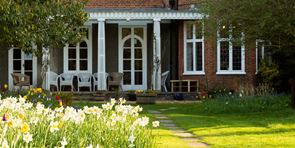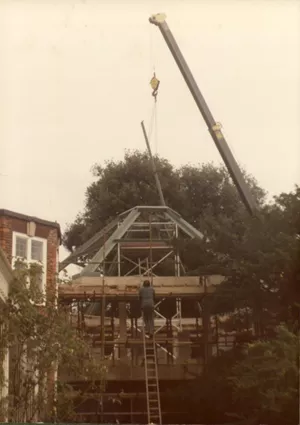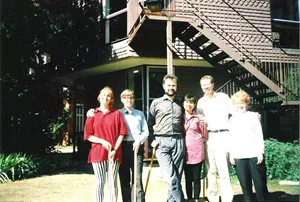The Gospels project: Memories from Tyndale House
Article
21st May 2025

Craig Blomberg reflects on his experience of working on the Gospels project at Tyndale House in the 1980s.
I will long remember my first visit to Tyndale House in the summer of 1980, while I was a PhD student in Aberdeen. The Tyndale Fellowship New Testament Study Group was meeting in the lounge with such luminaries as F. F. Bruce, I. Howard Marshall, R. T. France, Richard Bauckham, David Wenham, and Bruce Chilton. Participants presented papers on topics related to the Gospels project, a Tyndale House venture that would lead to a six-volume series entitled Gospel Perspectives, published by JSOT Press between 1980 and 1986. (France and Wenham co-edited the first three volumes, Wenham wrote the entire fourth one and edited volume five by himself, and I then helped him co-edit volume six.)
Early on, I heard talk that there were hopes of a single semi-popular volume that would distil the best of all the studies and supplement them as needed with related topics. Little did I suspect that a few years later, when I was teaching at Palm Beach Atlantic College, Florida, I would get a phone call from Murray Harris, the Tyndale House warden (as the principal was called in those days). He asked me if I would like to accept a UCCF scholarship to live at Tyndale House, with my wife Fran, and write that follow-up volume during the 1985–1986 academic year.

The issue of the reliability of the Gospels had long been close to my heart and one that sceptics often challenged me on when I shared my faith with them. So although it meant that I would postpone turning my doctoral work on the parables into a book, it was a dream come true.
By the time we returned to Cambridge in July 1985, the library extension (hexagon and carrels) had been completed, and I got to work in a brand new little office tucked between the hallway to the annexe and the main part of the library. I set up my Macintosh desktop computer and dot-matrix printer with views of the rose garden, which in those days was extensive. We lived on the first floor of the 1908 house, just off the stairway near the main entrance. In my office, I was the closest person to the phone box, which contained the one telephone available to library users, so I was frequently answering it and finding the people who were being called. At coffee and tea times, we met an amazing array of scholars from around the world. But the people I got to know best tended to be the PhD students staying long-term, including Markus Bockmuehl, Kevin Vanhoozer, Tim Savage, Philip Satterthwaite, and Mary Ann Beavis. Stan Porter came mid-year and we often had long late-night talks in the lounge after everyone else had gone to bed.
Some academic highlights of the year included gathering with a majority of the contributors to volume six of Gospel Perspectives, on the miracles of Jesus, for a multi-day conference in the hexagon to discuss their papers and suggest revisions just prior to publication. On another occasion, Morna Hooker, the Lady Margaret’s Professor of Divinity at Cambridge University, came, talked, and fielded questions in the lounge in an encouragingly informal setting.

I was also personally helped in my work by having Murray Harris, Donald Guthrie, and John Wenham assigned as readers of drafts of every chapter that I wrote. They made countless helpful suggestions for improving the text.
A brand-new technology called ‘camera-ready copy’ was being used with the Gospel Perspectives series. Someone typed the essays on specially provided sheets of paper the size of the pages of the book, preferably on an electric typewriter so that the ink came out perfectly even. Corrections with ‘white-out’ meant you could barely, if at all, see where they had been made. Then a high-resolution photograph was taken of each page, and the book was ready for production. The process of waiting a year or more for publication after submission of a manuscript was reduced to just a couple of months. Today, the volumes can appear somewhat amateurish to those who look at them, which explains why the industry returned to the longer, more tedious process of typesetting and printing.
In the midst of the dizzying technological advances and high-level scholarly conversations, Tyndale House always encouraged residents and library users to attend weekly chapel or prayer gatherings, and staff took a pastoral interest in those within the community. Fran and I participated in two or three services at our church and a home-group Bible study most weeks during term time. Lifelong friendships began in these contexts, as well as in Tyndale House. I learned again that academic work and Christian devotion need not be at odds with each other, but can be wedded. I hope that my book, The Historical Reliability of the Gospels (IVP, 1987; 2nd ed. IVP, 2007) has similarly promoted faith in the Jesus of the New Testament.
Thanks to our experiences in the 1980s at Tyndale House, we returned five more times between 1994 and 2022 for extended stays, either during summers or sabbaticals from Denver Seminary, where I have taught since 1986. More recent years have seen undertakings similar to the Gospels project on the Acts of the Apostles, Old Testament history at the time of the patriarchs, names in the ancient Near East and in the Old Testament, and New Testament textual criticism and the production of a Tyndale House Greek New Testament. In each instance, the goals of pairing the highest levels of scholarship with deep Christian devotion have been maintained and fulfilled. Add to that the unique collection of resources the library offers, the overall setting of Cambridge and its university, and the international collection of scholars and students that stream through its doors, and Tyndale House remains an unparalleled gift of God to the world. Although my wife and I turn seventy in the summer of 2025, we hope we have not yet made our last visit.